Lita Albuquerque on losing her home, art studio and Smithsonian-bound archives: ‘I have to let go’
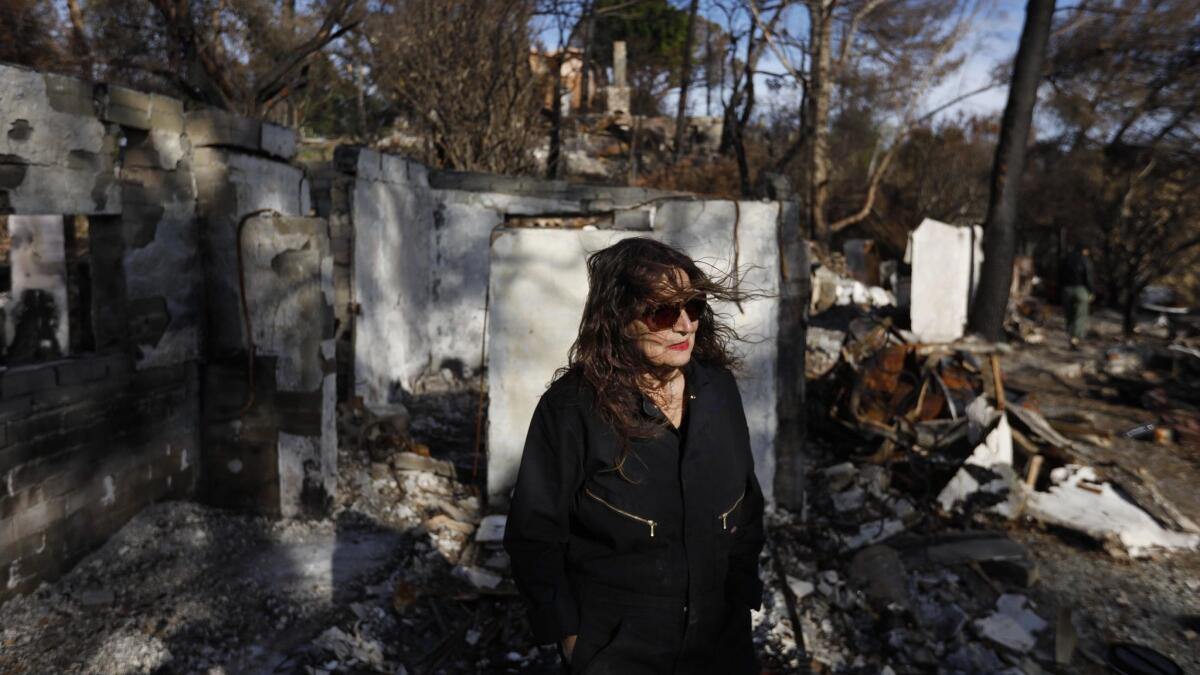
- Share via
Lita Albuquerque knelt down to get closer to the ground. The land has long doubled as her muse and her canvas: She drew constellations into Egypt’s Giza Plateau, she mimicked the night sky on a lake bed in the Mojave Desert, she aligned spheres to stars in space while in Antarctica on the summer solstice — 99 orbs in her signature ultramarine, a vibrant hue hearkening to the Tunisian skies of her childhood.
Kneeling atop a gravel plateau in Malibu, she reached for one of those spheres — or, rather, what was left of it. Now a semicircle shell with burned edges, it had been turned into a relic of the Woolsey fire, which tore through the seaside community in early November and destroyed the home, studio and archive of this renowned California artist.
“I mean, we’re talking about hundreds of hours of work here,” she sighed, holding the smoke-stained remains in her hands. “I have to let go of this, I really have to let go of this.”
By “this,” the 73-year-old artist meant more than just that piece of fiberglass. Those four letters encompassed the entirety of her home, a nine-structure property where she and her husband have lived since 1990 and raised their four kids. She called one building her sanctuary, a two-story space stacked with books on astronomy, philosophy and culture. Three steel shipping containers held thousands of her drawings, sculptures and paintings, as well as the supplies she used to make them.
All of it was gone. Five decades of artwork, tools and texts — crucial components of Albuquerque’s archive and artistic legacy. Within a few hours, reduced to ash-covered rubble.
Albuquerque led The Times around the property, which she visits three or four times a week. Despite such immeasurable loss, she demonstrated an incredible resilience and a steadfast respect for the ultimate ephemerality of nature — a foundational belief of her creative worldview. As her curly hair blew wildly in the wind, her grief often gave way to thoughts about the potential of a blank canvas.
Still, the fire left Albuquerque with new questions, like, who are you when you’re without all the things that make you feel like you? What is your past, and what is your purpose?
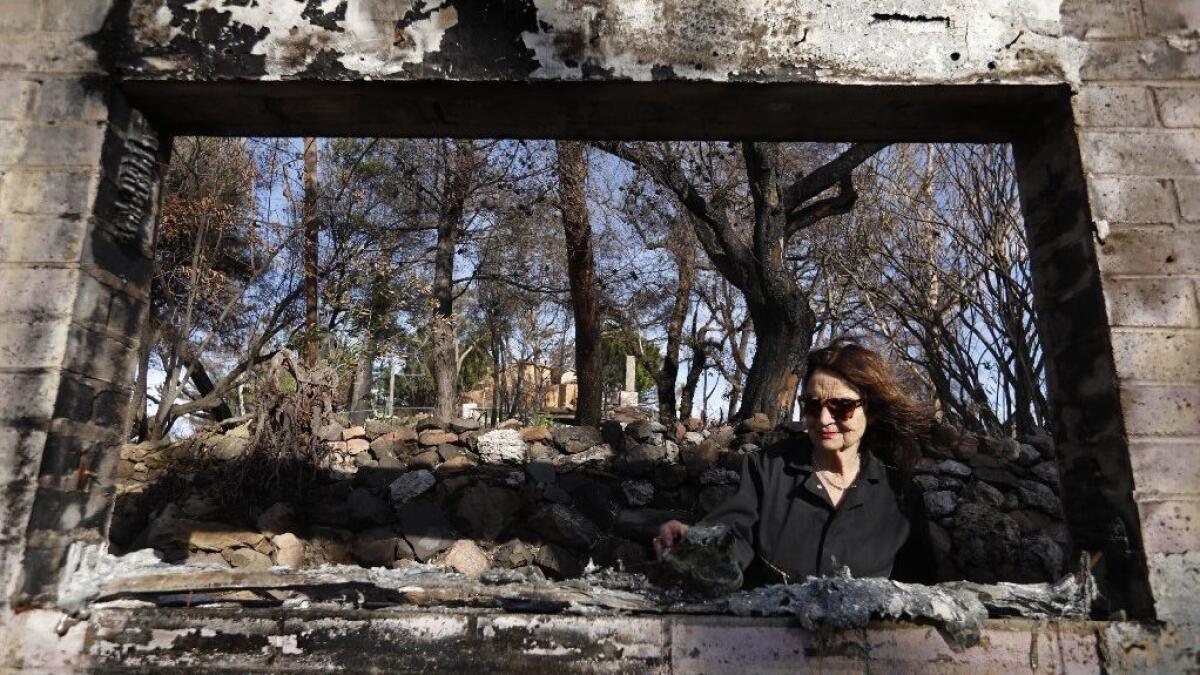
A frantic phone call
Albuquerque wasn’t in Malibu when the Woolsey fire broke out Nov. 8. She and her husband, Carey Peck, had spent their 30th anniversary in downtown Los Angeles, attending a performance at Walt Disney Concert Hall and then spending the night at the Standard hotel. She awoke at 5:45 a.m. to a call from her son, Christopher Peck, panicking in New York about the headlines of a fire near the 101 Freeway.
His sister, Jasmine Albuquerque, a dancer and choreographer who was eight months pregnant, was living at their mother’s home. Reached by phone, however, Jasmine told her mother that she saw no reason to worry. After all, no emergency alert had gone out via landline or cellphone. Still, an hour later Jasmine reassured her mother: She would evacuate anyway, joining 200,000 other residents of the area.
“We had her, and she had the dog, so we had everything,” Albuquerque said.
Equipped with only her overnight luggage (“I did pack three pairs of shoes, which was kind of amazing”) and her laptop (“I never go anywhere without my computer, thank God”), Albuquerque stayed with her daughter, Marisa Peck, in Venice for the “torturous” period that came next, wondering whether her home and studio had survived disaster in the days that followed.
“It really broke my heart,” Albuquerque recalled. “For three weeks, I woke up every single morning and cried for hours. Even now, I still do.”
MALIBU FIRE: For an 18-year-old artist, lessons from loss »
When she and her daughter finally managed to sneak up then-closed Highway 23, the artist saw how little remained of her hilltop home: charred metal chairs, demolished laundry machines, unrecognizable piles of debris.
The main structure — where her family hosted film screenings, dance performances and poetry readings — had lost its roof and windows and was filled with shattered ceramics and burned tree branches. All of her personal belongings, as well as those of her husband and her children (including daughter Isabelle Albuquerque), were gone. Curiously, a propane tank had not burst.
The roof of her studio — a covered workspace between her three shipping containers — no longer existed. Neither did a new set of sculptures or the 18 commissioned paintings she had been working on just days before. “They were 85% done,” she said. “I didn’t take any pictures of them. I didn’t even think to take pictures of them.”
Thousands of her drawings, stored in a steel chest of drawers, melted into solid black blocks. Her physical archive, with pieces dating back to her childhood, was ruined. Even the massive, memorable ultramarine figure from her Desert X installation, molded on the body of her daughter Jasmine, was gone.
“It was one of a kind, we can’t redo it,” she lamented. “People had wanted to buy it, and I was holding onto it.”
Just as rare: more than 40 pigments, some purchased from stores that closed years ago. “The ultramarine that I used, I had hundreds of pounds, and it’s all gone,” she said. “I can’t quite find a match. I’m still looking.”
Her tragedy has sent reverberations throughout the art community. “What a loss,” said Clayton Campbell, an artist and former artistic director of 18th Street Arts Center in Santa Monica.
“Fortunately, Lita is also an object maker who sells quite a bit of work, and she does have a lot of work that does exist in public. Some things can be reconstructed, but it’s an effort and there’d need to be real money and support to do this. I hope an institution steps up. She’s a significant artist, and over the course of time, is going to be seen even more so.”
Surprisingly, the property’s emptiness has filled Albuquerque with a kind of relief — the space to fully grieve the loss of her home and studio, and also a freedom from having so many things.
“I don’t have to be afraid of anything because, what else is there? I’m ready for the apocalypse!’” she said with a smile. “It’s a very interesting place a lot of [Malibu] people are in right now. We all have so much fear of this stuff happening, and when it does, it just is what it is.”
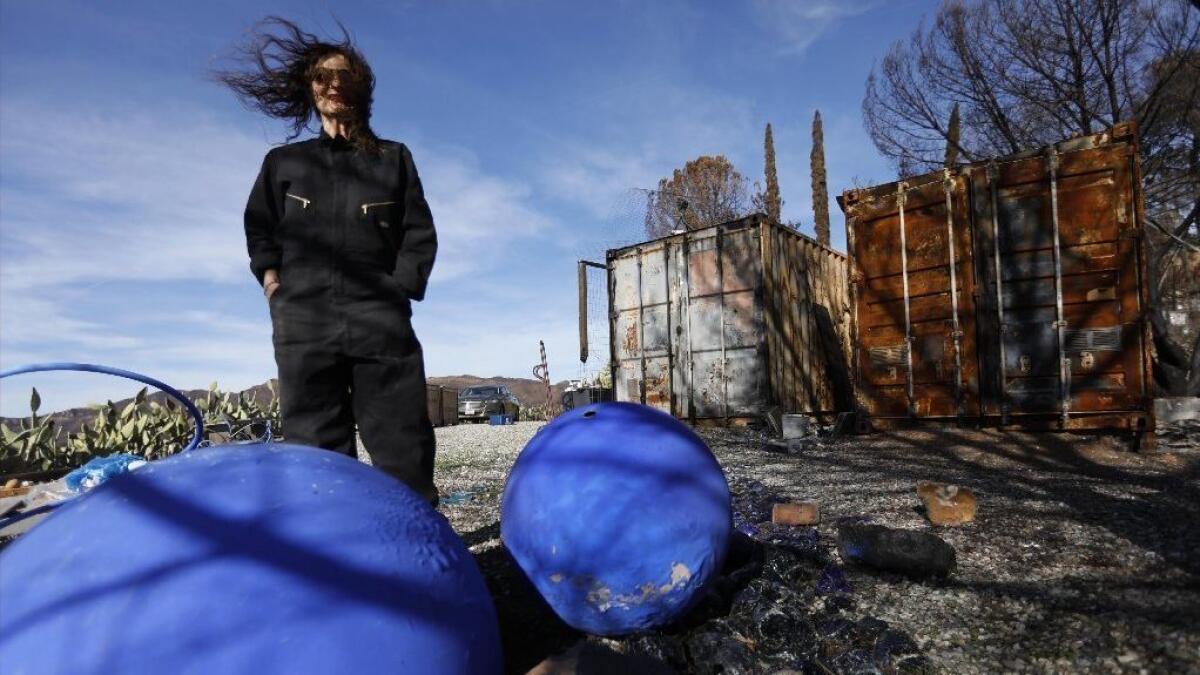
From the ashes, inspiration
Albuquerque was about to cancel a career-spanning Nov. 29 lecture at the Laguna Art Museum when a friend suggested she use the event to get back to creating, via a performance.
“When she said that, all of a sudden, I got so excited,” Albuquerque said, her eyes widening and her speech quickening. “I got the power of art.”
Ten minutes before the event was to begin, Albuquerque still didn’t exactly know what she’d perform. Dressed in a black utility jumpsuit and her hands and face painted blue, she took the stage and ended up reflecting aloud for 90 minutes.
“I was so raw,” she recalled. “I talked about being Lita, the artist and persona, and Lita, the person. Because even though I’m known and I’ve got my work out there, I was so shy to show the part of me that did burn.”
And by that she meant the parts she hadn’t believed were important. A book she started back in 1985. Written reflections on parchment paper. Fifty boxes of notebooks, sketches, photographs and other relics that outlined her creative process since the 1970s.
She and Ami Sioux, a photographer and longtime friend, had spent weeks sorting through every single paper at the request of the Smithsonian Institution’s Archives of American Art. At first, the request was laughable, Albuquerque said. “For a long time, I said, ‘You don’t want these notes, or this letter I wrote when I was 19 in Paris and being arrogant!’”
In fact, that’s exactly what the Smithsonian desired.
“Her handwritten notebooks of brainstorming, instruction sheets from her early performances, photographs from her first marriage with [noted photographer] Steve Kahn — it was all very personal and very inspired,” said Matthew Simms, the West Coast collector of the Smithsonian’s Archives of American Art.
“So much of those things that document the process is almost the underpinning of the work that got produced. It’s integral to the work itself.”
MALIBU FIRES: A location scout loses years of photography documenting vintage New York »
The archive discussions, paused when the fire hit, have recently resumed, and Albuquerque and Simms may collaborate on an oral history.
Albuquerque wished she hadn’t minimized the importance of these items over the years, not only to the museum and art dealers but also to herself. She used to think her papers were worthless when, in fact, they were priceless.
“It’s all about the importance of seeing your own value,” she said. “We all have this thing of, we don’t honor who we are. We have to because, once it’s gone …
“Now, I’m like, all of it has to come out. I will never not recognize who I am again.”
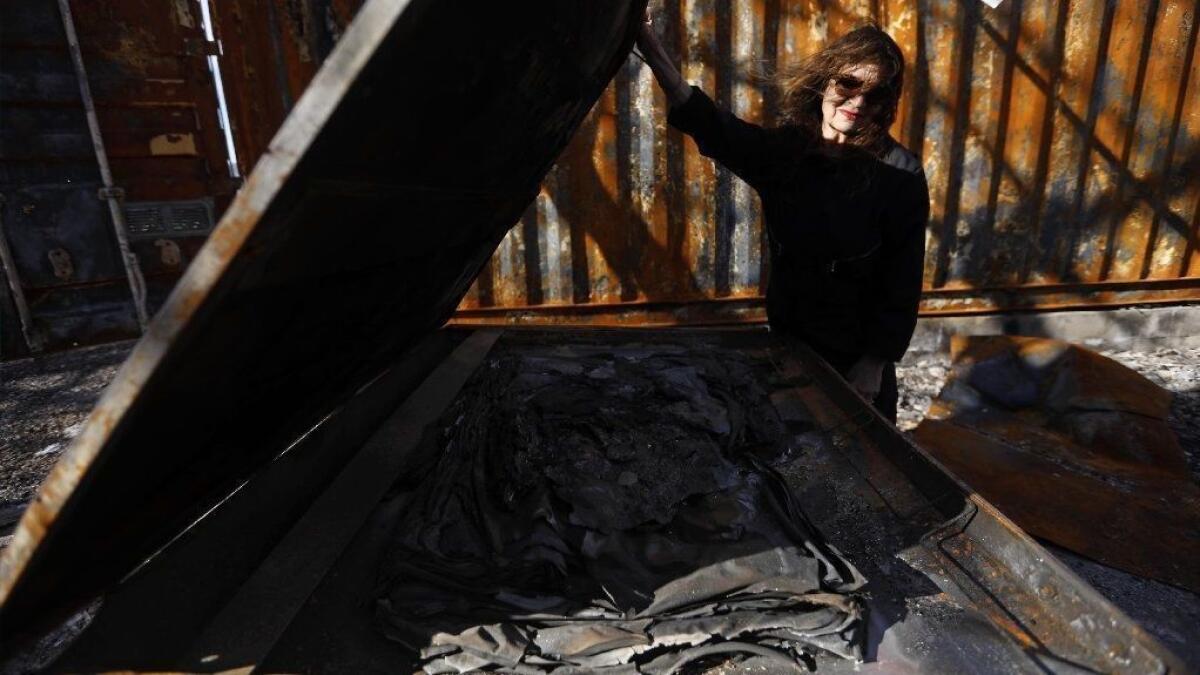
‘Look at this beauty’
During the course of a two-hour interview and walk through the Malibu burn site, Albuquerque occasionally paused, gazed upon the rolling hills and admired the light on the ocean. Despite her loss and the ever-present threat of wildlife in the region, the artist plans to rebuild.
“Look how fast the green has already grown back,” she exclaimed joyfully, standing atop a stone mosaic platform built by her husband that overlooks the hills and horizon. “It took me a long time to find this place, somewhere with this kind of openness in nature. You can see the stars at night. And my work is so much about this, nature.”
And work she has done: settling into a temporary home in Century City, teaching classes at ArtCenter College of Design in Pasadena, replacing essential documents like her driver’s license and passport. She completed a commissioned set of drawings and has been filling up notebook after notebook with her writing. The day before The Times interview, she put together a pigment piece that “looked like the birth of stars,” but it blew away overnight. “Truly ephemeral,” she said with a laugh.
As Albuquerque spoke, Sioux resumed her careful sift through the debris, racking through the rubble and meticulously sorting found materials by type. Collections of glasses and metals covered the area around the main structure. The scene looked less like a family home and more like an archaeological dig.
“With the rain and the winds recently, we had to move very quickly,” Sioux said. “What has been done to the surfaces by the fire has been very frightening and fascinating.”
Some of these items will be included in the Metabolic Studio’s Special Projects in Archiving, instigated when a notable marker of cultural history will be or has been lost. But other found materials could be part of a future Albuquerque creation. While lamenting the loss of her work inside the steel containers, the artist couldn’t help but note its new finish.
“This texture, wow, it’s really beautiful,” she said of gray walls wearing streaks of burnt orange and cedar brown. “I’m thinking of cutting them and making something with them.”
Walking amid the rubble, Albuquerque approached one particular pile of objects. She picked up remnants of scholastic medals that her mother won as a teenager. They were stored on top of her ashes.
“Finding these things, even though I can’t use them, it’s very helpful,” she said with a shrug. “I don’t know why we as humans have such a need for that, but they’re nice to have.”
She held one up in the sunlight, just above where the sky meets the ocean. “Who knows what they’ll become.”
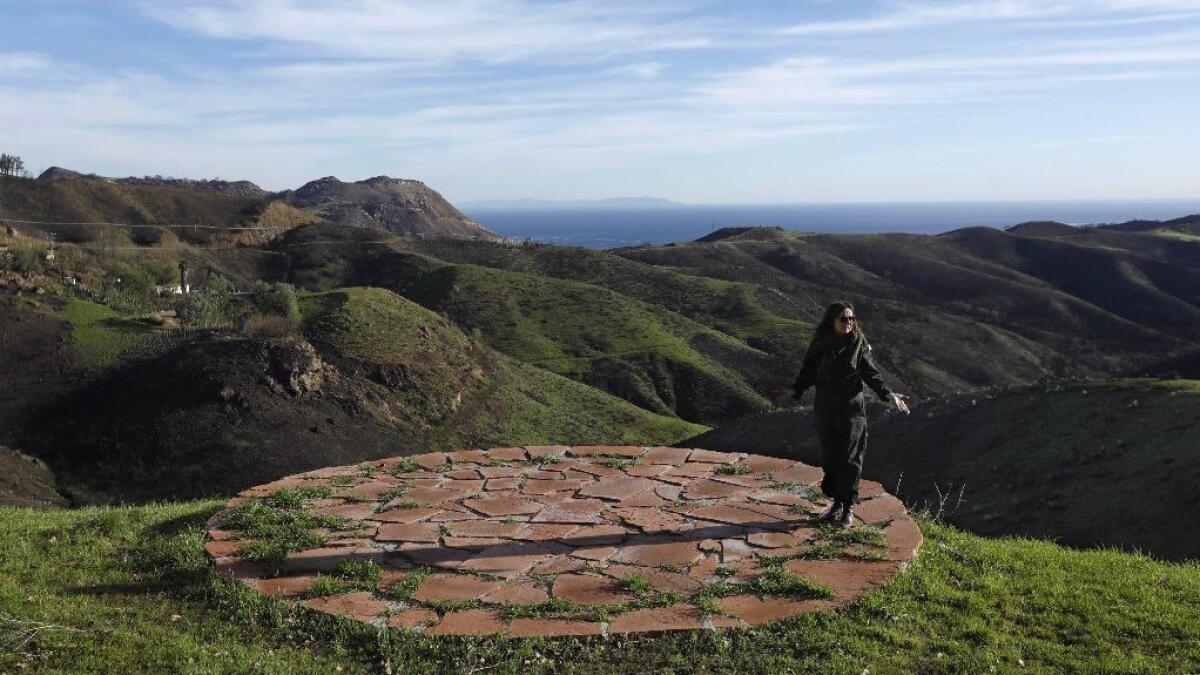
Twitter: @cashleelee
More to Read
The biggest entertainment stories
Get our big stories about Hollywood, film, television, music, arts, culture and more right in your inbox as soon as they publish.
You may occasionally receive promotional content from the Los Angeles Times.











